
Harry Potter: “Can you learn how to be a Metamorphmagus?“
Nymphadora Tonks: “Bet you wouldn’t mind hiding that scar sometimes, eh?“
Harry Potter: “No, I wouldn’t mind.“
Nymphadora Tonks: “Well, you’ll have to learn the hard way, I’m afraid. Metamorphmagi are really rare, they’re born, not made. Most wizards need to use a wand or potions to change their appearance….” “I’m a Metamorphmagus. It means I can change my appearance at will. I was born one.“
Metamorphmagi could change their appearance completely to look like anyone they chose. They could even change just a part of their appearance – color of hair, or shape of nose.
A Metamorphmagus was born, not made. It was not a magical skill that could be learned.
Unlike the Metamorphmagi who were born shape-shifters, we can train ourselves to shape shift our competencies. This can prolong our careers and expand our earning potential. That’s what I discuss in this edition:-
- Expertise comes in different shapes
- Our foundational years are designed to make us hyphen-shaped
- I-shaped people command high market value
- This is the paradox of specialization
- Shape-shifting prolongs our career life span
- How do we shape-shift
Expertise comes in different shapes
When we learn how to drive on our dad’s old Maruti, we don’t need a new driver’s license each time we want to drive a Honda, Toyota, or an Audi.
When we learn the fundamentals of baking , we can bake bread, pies, cakes, muffins and cookies.
In both these examples, we acquire a breadth of expertise, and become generalists, or Hyphen-shaped people.

On the other hand, a car driving license does not qualify us to fly Elon Musk’s latest rocket ship.
If instead of a general baking class, we take an eight-week sourdough class, we become expert bakers in sourdough breads.
When we dive deeper into one skill, we become specialists, or I-shaped people.

Our foundational years are designed to make us hyphen-shaped
The early years of our education and careers are weighted in favor of hyphen-shaped training, followed with intense bursts of I-shaped skill building.
In school, we consume a time tabled diet of multiple subjects – history, civics, geography, mathematics, physics, chemistry, biology, arts, multiple languages, sports. We are also encouraged to take up as many hobbies as we can. Along with this, we learn a multitude of life skills as we get older -cooking, driving, finances, relationship building, shopping and so on.
Even in graduate and post graduate education, the first year focuses on general skills in that particular field of study. For instance, a B.Com. student will build a foundation in economics, accountancy, taxation etc. and only then specialize in taxation, or audit.
Jobs follow the same playbook. Management trainees work across multiple functions, before finally joining one, to start their journey of specialization.
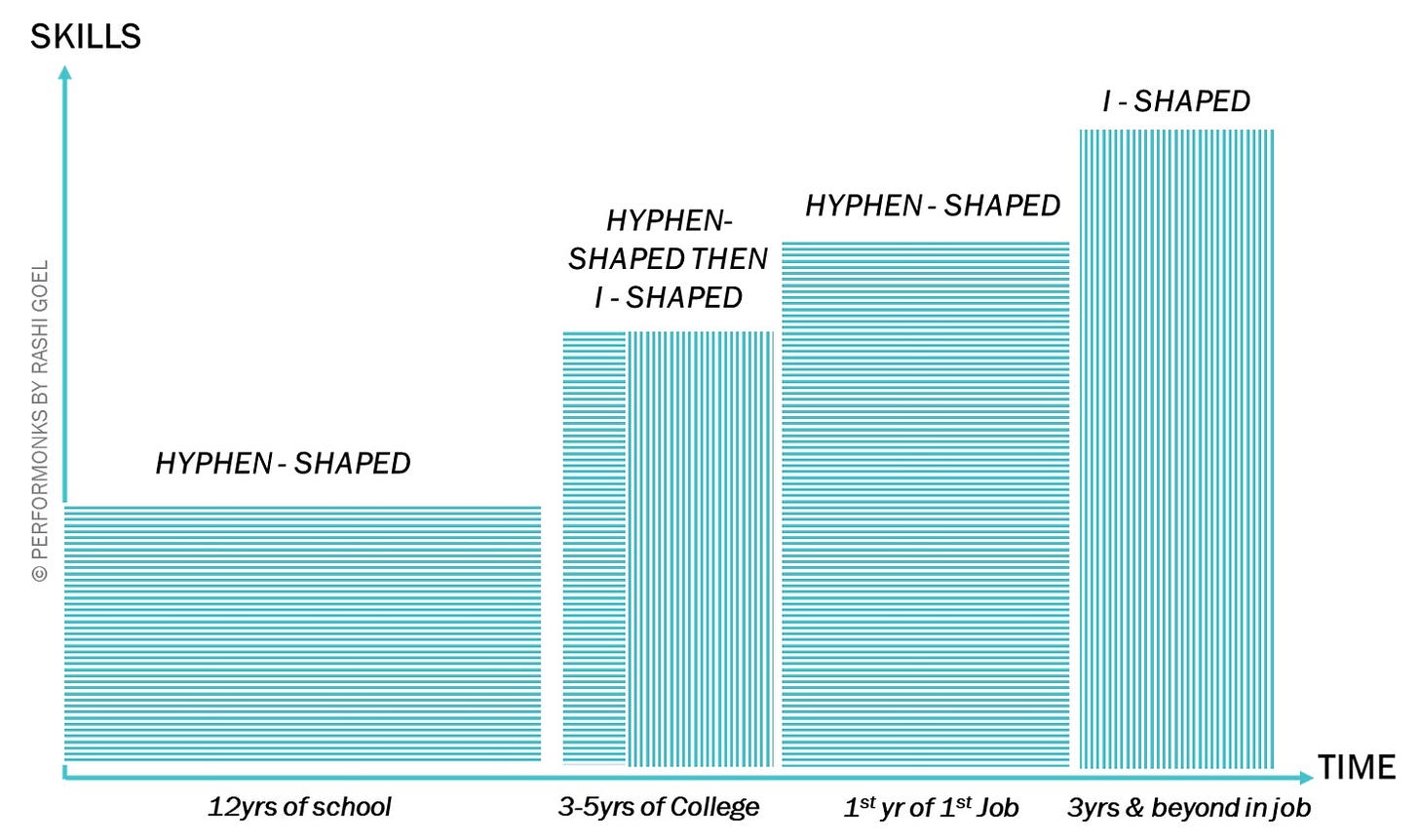
So for the first two decades of our life, we focus on increasing the surface area of our learning, to build a strong foundation of interconnected life skills, experiences, general knowledge, and education.
Without this foundation, we would be like a taxi driver who knows only one route in the city – not of much use to anybody with a different destination.
I-shaped people command high market value
With enough time, training, and practice, we become I-Shaped or super specialists, and our market value increases. That’s why an Astronaut is paid more than an Uber driver, and a celebrity baker is paid more than the local baker.
The value an I-shaped person can command is subject to the size and interest of the addressable market for the specialization. Two scenarios play out for super specialists.
The first scenario is when the super specialist becomes a superstar. S/he contributes at a genius level to society and culture. Across sports (Sachin Tendulkar Michael Phelps), invention (Elon Musk, Einstein), culture bending creativity (BTS, The Beatles), excellence in a craft (Amitabh Bachchan, Pandit Ravi Shankar, Neil Gaiman) and so on. There are only a handful of pioneering innovators who see this level of celebrity status. But this level of fandom has a shelf life. Once the market loses interest or the next pioneer enters, the super star fades into oblivion.
The chart below illustrates this by tracing how market value catapults as specialization and genius grows… but then declines once interest fades or the next new thing bursts onto the scene.
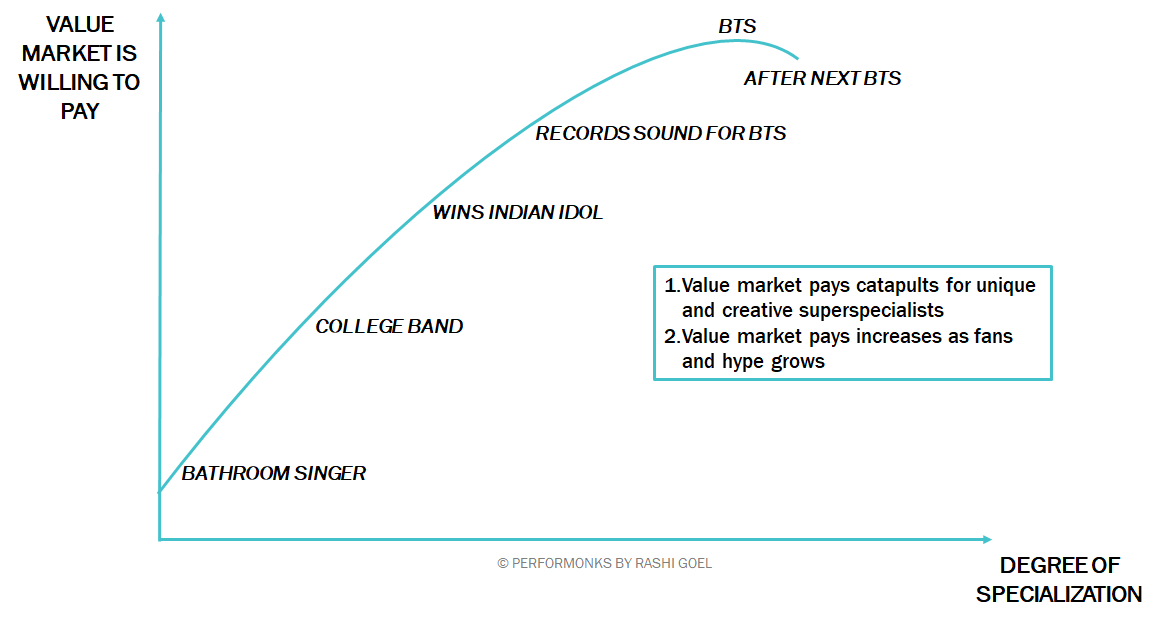
The second scenario is when the super specialization is highly valued, but the market for it is relatively smaller. For instance, there are millions of car drivers, but only a handful of Astronauts. The market is willing to pay more value as specialization increases, but over time, a super specialist starts experiencing value shrinkage.
The chart below illustrates this.
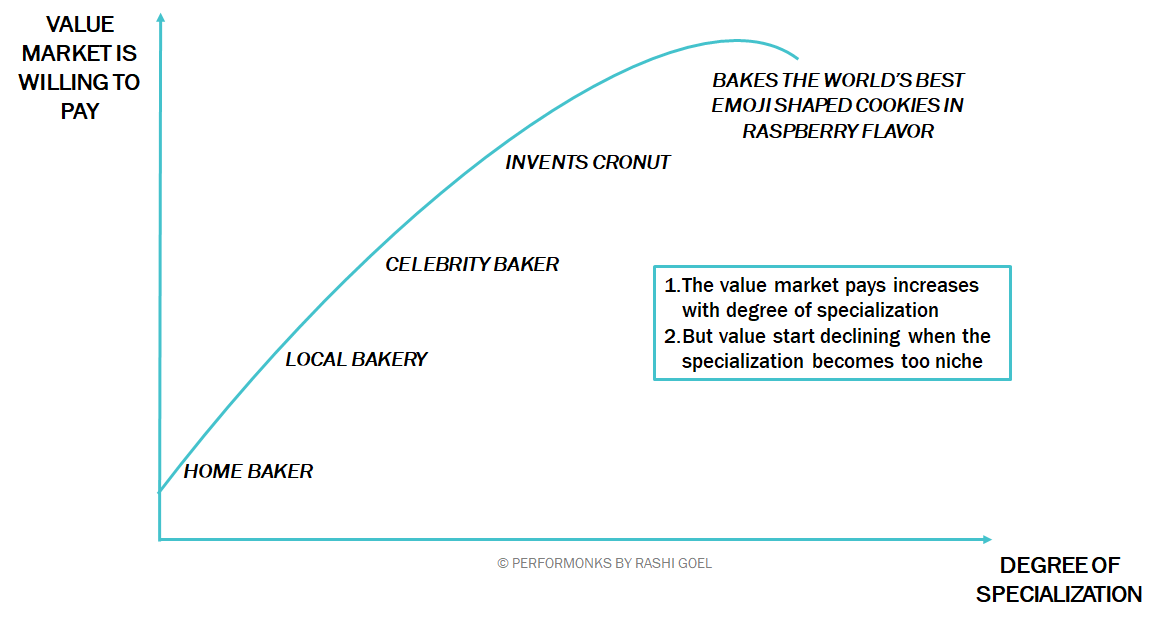
This is the Paradox of Specialization
In the first few years of our career, it is good to be I-shaped. But 20+ years into their career, super specialists (I-shaped people) become hammers in search of nails. Market mobility might shrink and more importantly, some specialists start getting weary of their field and seek freshness.
Therefore, it is important to shift shapes and become T-Shaped, Pi-Shaped or Comb-Shaped by adding skills and competencies to our arsenal before it gets too late.
“The future belongs to the integrators.”
Ernest Boyer
T-shaped
T-shaped people have broad experience in different disciplines and deep expertise in one field.
Most CEOs are T-shaped. They have deep expertise in one aspect of the business they run, along with enough cross-functional awareness and people management competency.

Another way to explain T-shaped is to use Tim Ferris’ example, where he draws a distinction between a cook and a chef.
He says a cook is someone who delivers the perfect dish by following a recipe to the last detail. But struggles to improvise when an ingredient is missing or something goes wrong. A cook is an I-shaped person.
A chef on the other hand, takes the fundamentals of cooking, ingredients and cuisine, combines it with his or her own creativity and creates original dishes. A chef does not get fazed by challenges like missing ingredients. A chef is T-shaped.
Which restaurant would you like to eat your anniversary dinner at? One run by a cook, or a chef?
Pi-shaped
Pi-shaped people have broad experience, but combine it with deep expertise in two separate domains.

Oliver Sacks, a trained doctor, built a career out of deep expertise in two fields – neuroscience and storytelling. He had a gift of writing about unusual experiences of his patients as insightful stories. He wrote so well that some of his books were adapted for plays and movies.

Comb-shaped
Comb-shaped people are polymaths. They have expertise in multiple areas. While they may not have equal depth across all the areas, they have sufficient depth in each. Each area then feeds the other and this ‘sum is greater than the parts’ cocktail creates a genius level career trajectory.

Elon Musk is, and Leonardo da Vinci was comb shaped. Elon Musk is a genius inventor, with expertise in electric cars, space travel, solar energy, AI, crypto currency. He is also a social media influencer with 63mio twitter followers!
We all know about Leonardo da Vinci. He was a painter, engineer, sculptor scientist, and architect. He was a keen observer of nature and botany, biology, human anatomy and cross-pollinated ideas from one subject to the other.
Shape-shifting prolongs our career life span
We shape-shift our brands too. And we do this deliberately, to a calendar. To continue to grow our market share, we add benefits to our product offerings. We launch new products under the same brand. We evolve our communication, packaging, logo, even our business model. We call this innovation and we know that this gives a new lease of life to the brand.
In the same way, I urge you to consciously and deliberately add expertise to your skills arsenal. This chart below captures an ideal version of skill evolution, wherein with each leveling up of skills, we not only prolong our career, but also create a new growth trajectory.
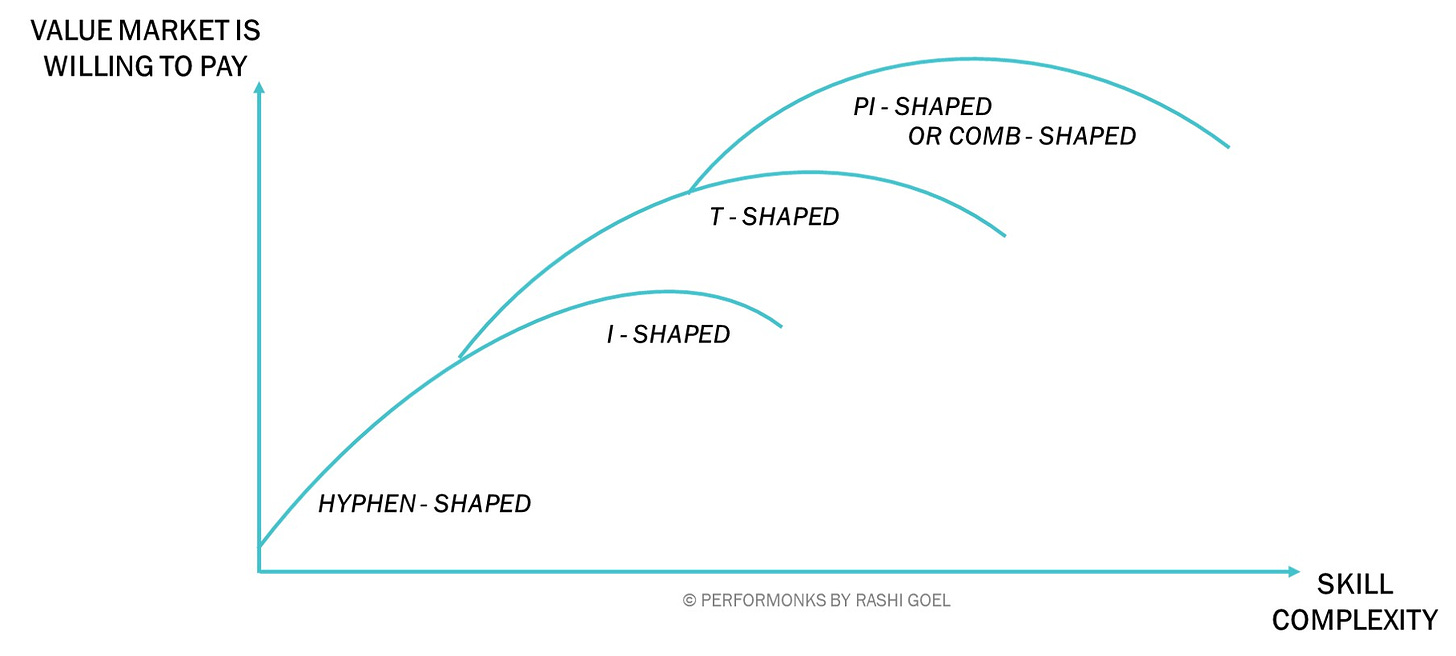
TL:DR. To prolong our productive lives, we can and we must shape-shift by learning across multiple disciplines.
How do we shape-shift?
It is easy to say we should shape-shift our skills. But how?
I lean on a model developed by Jake Chapman, published in this TechCrunch article. He asks, if we had 100 units of time to learn skills throughout our life, how would we spend our time?
He recommends spreading those 100 time units across multiple subjects, to become a well-rounded person by applying the Pareto Principle. If for the right skill, 20% input gives 80% output, mathematically, focused chunks of input=time spent on learning a new skill can be a force multiplier of output=new skill. As we see in the table below.
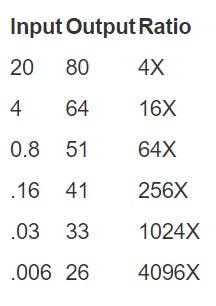
To be honest, I did not quite get what Jake Chapman was trying to say, until I came across James Whitehead’s article on LinkedIn. He has converted this model into a mastery inventory below.
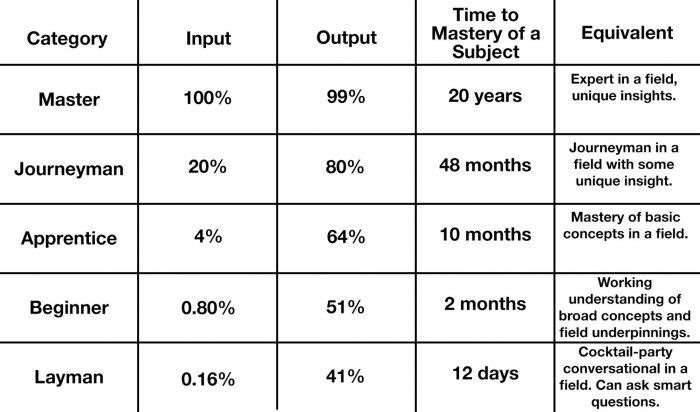
I broke this down like so. Just 12 days of focused study (Byju’s, Unacademy etc.) can give us ‘cocktail-party’ level of expertise. 2 months of focused study (an internship) can ready us to execute basic projects…and so on.
Shape-shifting boils down to chunking up diverse skill building over our career lifetime. And we can start anytime.
As the wise Yoda would say, “Do or do not, there is no try”.

Thanks for reading!
